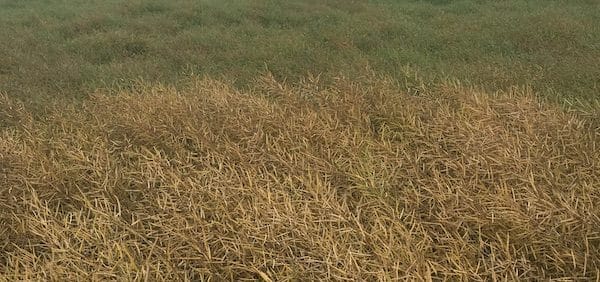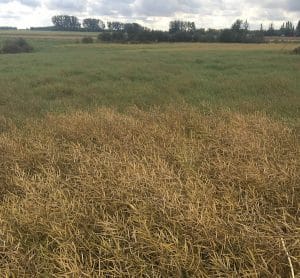Canola plants yellowing pre-maturely could be infected with clubroot. The disease continues to spread and tends to be much worse in fields with excessive tillage, tight rotations (one-year break, or less) and high spore loads. While doing your pre-harvest disease scouting, make sure to dig up plants to check for galls.
If you find a patch of canola plants with clubroot galls, take action now to contain it. This is especially important (1) if clubroot is new to the farm or (2) if the field is seeded to a clubroot-resistant (CR) variety and the patch could have a new pathotype that you need to contain.
If the patch is small, dig up the infected roots, put them in a garbage bag and take them to the landfill. Then make sure to leave the patch untouched by tillage or any other operation that would move soil beyond the patch.
Why is patch management important? Spore loads will be very high in that patch and could reduce canola productivity in that area for years. Clubroot will often start in small patches and if a farm can identify those patches early and keep them contained, it can be an extremely important step in managing the disease. Discovery of a patch can also inspire a review of crop rotation to extend the break between canola crops to a minimum two years (three-year rotation), and encourage the farm to increase biosecurity practices to limit soil spread. In areas of Alberta that have been battling clubroot for more than 15 years now, more than a dozen fields have so much clubroot, including pathotypes that can overcome CR varieties, that canola is not a viable economic crop on that land. That is why identifying and containing clubroot patches is so important.
Once the patch is defined, a good next step would be to seed the patch to a perennial grass. This could be done now to see if the grass can get established before freeze up. If conditions are not suitable (too dry, too cold) for establishment, the next best patch-seeding time is likely early spring.
How to establish a patch of grass
Step 1. Identify the patch dimensions by pulling plants in all directions until NO GALLS can be seen on the roots. At a minimum, extend the radius of the patch by about 50% from that point and seed the whole expanded area to grass. (The grass-patch area should be approximately double the area where clubroot galls were determined to be present.)
Step 2. Choose a grass species or blend. Although research is showing that certain grasses may be slightly better than others at coaxing spores out of dormancy and more quickly reducing spore loads (Fleet meadow brome and common smooth brome showed good results), the purpose of the grass is to establish a thick stand that holds soil in place.
Step 3. Seed the patch. Surface application (with a Valmar, for example) and a light harrowing is often enough for grass seed. Shallow seeding is optimal. Regardless of how the grass gets seeded and/or incorporated, make sure to not drag soil outside the patch. Clean off the equipment before leaving the infested patch so contaminated soil is not transferred outside this patch. For specifics on seeding rates and other valuable grass-establishment tips, refer to the ‘How to establish grasses’ section in this guide.
Step 4. Once the patch is established, spray as needed to keep out volunteer canola and other clubroot hosts. Known clubroot hosts include canola volunteers, brassica weeds (flixweed, stinkweed, shepherd’s purse, wild mustard), tame mustard, camelina and most other brassica crops and brassica vegetables. Leave the grass in place for at least three years before returning to annual crops. Five to seven years may be required if clubroot was so severe that plants in the patch were all dead in July.


